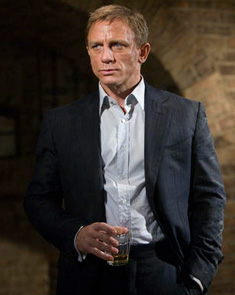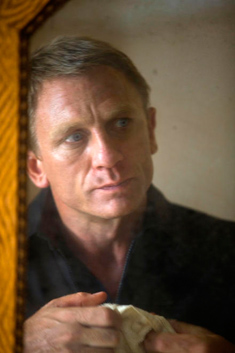|
EMPIRE
by
Kim Newman
Plot
Still angered by the death of Vesper Lynd, James Bond (Daniel Craig)
goes after the shadowy international organisation he holds responsible,
even when M (Judi Dench) orders him to stand down. Bond clashes with
Dominic Greene (Mathieu Amalric), who is cornering Bolivia’s water supply,
and teams with Camille (Olga Kurylenko), who has her own mission of
vengeance.
Review
Quantum Of Solace picks up moments after the credits rolled at the
end of Casino Royale, with Daniel Craig’s bereaved and blooded Bond
in Siena, wrecking his Aston Martin in a pre-credits car chase complicated
by thick traffic, twisty mountain roads and emotional Italian drivers. In
his car-boot, with a bullet in his leg, is Mr White (Jesper Christensen),
a higher-up in the cartel (Quantum) which employed and then killed the
baddie of the earlier film, and who Bond blames for the death of the girl
he loved last time round. Mr White is taken to be grilled by M, just as
the local horse race (the palio) is taking place (obviously, the
filmmakers saw the documentary The Last Race too), only for the
villain to sneer that MI6 and the CIA obviously know nothing about
Quantum’s many well-placed agents, whereupon someone presumably
trustworthy pulls a gun – and Bond is back in action, leaving wounded
enemies and allies behind as he barges through crowds, runs up stairs,
dangles from scaffolding and dodges swinging girders to get his man. |
 |
|
In an era marked by
franchise bloat, it’s entirely admirable that Quantum of Solace is
the shortest Bond movie to date – it drops a great many of the
long-running series mannerisms (callous quips, expository lectures,
travelogue padding, Q and Moneypenny) as it globe-trots urgently from
Italy to Haiti to Austria to Italy again to Bolivia to Russia with
stopovers in London and other interzones. The major gadget on offer is a
neat trick with a mobile phone, which the film trusts us to follow without
a pompous lecture on how it works, and there’s a nod to traditionally
absurd Bond girl names in Gemma Arterton’s Agent Fields – she refuses to
give her real, silly, embarrassing name which we only find out from the
end credits (it’s not Gracie or London). Everything in this movie is
edited as if it were an action sequence, which means that when the
set-pieces come they have to go into overdrive to stay ahead of the game,
with Bourne veteran Dan Bradley staging more brutal, devastatingly fast
fights and chases. We get striking locations (including primaeval caves
and a South American desert) and absolutely gorgeous, stylised art
direction – but there’s little lingering on the backdrops, since a brief
establishing shot is usually enough to set up the nimble, nifty, explosive
action that takes place against them.
Previously, the Bond films have been a series, but this is an actual
sequel – an approach Ian Fleming used in his books, but which was dropped
from the movies because the novels were filmed out of order. This makes
for a film which hits the ground running, but also means we get less to
latch onto emotionally since Daniel Craig became the complete 007 over the
course of Casino Royale, and here just has to be set loose. The
sparks struck between the wounded hero and scarred heroine Camille – whose
revenge-driven sub-plot owes a lot to Judy Havelock, the girl from the
story FOR YOUR EYES ONLY – don’t match those between Craig and Eva Green
last time round because this Bond is human enough to start worrying about
how regularly his girlfriends get killed. The slinky, sultry Olga
Kurylenko is in fact so fixed on murdering her enemy that it’s possible
she technically doesn’t even count as a Bond girl – she’s good, but
doesn’t get the breakout showcase Green landed in Casino Royale.
However, for the diehard romantics, Bond does tenderly hug a dying male
friend before disposing of his corpse in a dumpster (‘he wouldn’t care’)
and gives Camille handy tips on professionally assassinating the extremely
unpleasant would-be dictator who slaughtered her family.
Casino Royale had one of Fleming’s best plots to stick to, but Quantum
of Solace is on its own, taking only its title from the 1960 story.
Extrapolating from hints dropped in the earlier film about who ran the
late Le Chiffre, it introduces Quantum, a SPECTRE-type organisation which
ought to be good for a few more movies. The notion of an international
alliance of high-stakes criminals with heavy political ties is
Flemingesque, but gets a credible, cynical 21st Century spin in that the
American and British governments (and security services), above criticism
in Fleming’s day, are perfectly happy to get in bed with killers and
megalomaniacs so long as the oil keeps flowing – which forces Bond out on
his own, pursuing a crusade either for utterly altruistic (helping
drought-blighted Bolivian peasants) or utterly selfish (getting his own
back on the one small fish directly responsible for Vesper’s plight)
motives. Quick jabs evoke highlights of the earlier films, as Craig’s
sea-bathing in Casino Royale referenced Ursula Andress in Dr No;
one major character’s fate is a stark black updating of one of the most
famous early Bond images, and signals which commodity has become most
prized in a world where Goldfinger or Blofeld would seem like jokes.
Daniel Craig continues to be his own man as Bond, though this instalment
scarcely gives him breathing room between strenuous activity to show off
his more stylish or snobbish aspects. When he chugs his signature martini
(take notes as the bartender rattles off the recipe) even devoted allies
worry that seven brain-numbing drinks in a row might not be good for the
agent’s long-term mental state or ability in the field. Craig looks good
in a tux, blending into the crowd at an opera first night where the
villains have convened to mutter evilly through Tosca, and wears his
bruises and scratches like badges of honour. He shows a certain expense
account flair in turning down a modest La Paz pensione to check into the
poshest hotel in the city by insisting that the ‘teacher on sabbatical’ he
is pretending to be has won the lottery. But, presumably coached by
Bradley, he is at his most elegant in tiny action moments – upending an
idling motorbike to send a minor thug flying, casually stepping off
balconies and walking along ledges, efficiently crippling a liftful of
agents trying to arrest him.
With all the ills of the world down to Quantum, the baddies we see are –
like those in Dr No, From Russia With Love and Thunderball –
junior associates of archfiends who operate at such a high level we don’t
even get to meet their cats. The French Mathieu Amalric makes the smarmy
fake environmentalist Greene a suitably loathsome character, as much for
his persistently cruel treatment of his mistress Camille as his
complicated scheme to overthrow the government of Bolivia and grab the
country’s natural resources; like Mads Mikkelsen’s Le Chiffre, he’s young
and fit enough to hold his own in a scrap, but has a nice line in craven
delegation, posing a minion with a gun to face certain death as he tries
to escape the climactic spectacular conflagration, and gets some of the
smart, threatening, witty script patches we assume Paul Haggis dropped in.
A nod also to the Mexican Joaquin Cosio, who plays a South American
would-be dictator whose filthy foreign habits (like celebrating a big deal
by raping a waitress) Fleming would have enjoyed despising.
Verdict
A pacy, visually imaginative follow-up. If it doesn’t even try to be
bigger than Casino Royale, that’s perhaps a smart move in that
there’s still a sense at the end that Bond’s mission has barely begun and
he’ll need a few more movies to work his way up to destroying the
apparently undefeatable Quantum organisation. The only real caveat is that
while it’s exciting, it’s not exactly anyone’s idea of fun. To keep in the
game, perhaps the next movie could let the hero enjoy himself a bit more.
4/5 |

